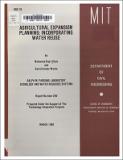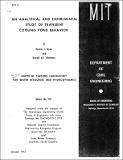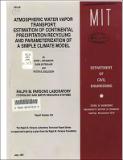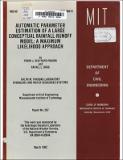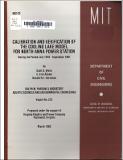Browsing Reports by Title
Now showing items 1-20 of 120
-
Agricultural Expansion Planning: Incorporating Water Reuse
(Cambridge, Mass. : Ralph M. Parsons Laboratory, Hydrology and Water Resource Systems, Massachusetts Institute of Technology, Dept. of Civil Engineering, 1982-03)A mathematical model has been built to guide decisions required for agricultural expansion planning. Of particular interest is the case when some, or all, of the irrigation sources available have saline water. These decisions ... -
The Analysis of River Basins and Channel Networks Using Digital Terrain Data
(Cambridge, Mass. : Ralph M. Parsons Laboratory, Hydrology and Water Resource Systems, , Massachusetts Institute of Technology, Dept. of Civil Engineering, 1989-09)This work examines patterns of regularity and scale in landform and channel networks. Digital elevation model data sets from throughout the United States are used as a data source. First we consider the two-dimensional ... -
An Analytical and Experimental Study of Transient Cooling Pond Behavior
(Cambridge : Ralph M. Parsons Laboratory for Water Resources and Hydrodynamics, Dept. of Civil Engineering, Massachusetts Institute of Technology, 1973-01)Cooling ponds offer many advantages as a means of closed cycle heat dissipation. These are simplicity, low maintenance.and power requirements, aesthetic and possible recreational values, and high thermal inertia. A cooling ... -
Atmospheric Water Vapor Transport: Estimation of Continental Precipitation Recycling and Parameterization of a Simple Climate Model
(Cambridge, Mass. : Ralph M. Parsons Laboratory, Hydrology and Water Resource Systems, Massachusetts Institute of Technology, Dept. of Civil Engineering, 1991-07)The advective transport of atmospheric water vapor and its role in global hydrology and the water balance of continental regions are discussed and explored. The data set consists of ten years of global wind and humidity ... -
Automatic Parameter Estimation of a Large Conceptual Rainfall-runoff Model: A Maximum Likelihood Approach
(Cambridge, Mass. : Ralph M. Parsons Laboratory, Hydrology and Water Resources Systems, Dept. of Civil Engineering, Massachusetts Institute of Technology, 1982-03)A stochastic parameter estimation procedure to be applied to large conceptual rainfall-runoff models is proposed. The procedure is based on a maximum likelihood approach, which is enhanced to allow for the use of prior ... -
Calibration and Verification of the Cooling Lake Model for North Anna Power Station: During the Period July 1978 - September 1981
(Cambridge, Mass. : Ralph M. Parsons Laboratory, Aquatic Sciences and Environmental Engineering, Dept. of Civil Engineering, School of Engineering, Massachusetts Institute of Technology, 1982-03)The North Anna Power Station (3 proposed nuclear units with a total capacity of 2820MWe) is located in the State of Virginia about 41 miles northwest of Richmond. The plant condenser heat dissipation system consists of a ... -
A Channel Network Evolution Model with Subsurface Saturation Mechanism and Analysis of the Chaotic Behavior of the Model
(Cambridge, Mass. : Ralph M. Parsons Laboratory, Hydrology and Water Resource Systems, Massachusetts Institute of Technology, Dept. of Civil Engineering, 1990-09) -
Chemically Enhanced Wastewater Treatment
(Cambridge, Mass. : Ralph M. Parsons Laboratory, Aquatic Science and Environmental Engineering, Massachusetts Institute of Technology, Dept. of Civil Engineering, 1990-09)Many municipalities are currently under court order to provide secondary-level treatment to their wastewater. Since federal funding is no longer available to build the necessary facilities, the burden of paying for secondary ... -
Climatology of Station Storm Rainfall in the Continental United States: Parameters of the Bartlett-Lewis and Poisson Rectangular Pulses Models
(Cambridge, Mass. : Ralph M. Parsons Laboratory, Hydrology and Water Resource Systems, Dept. of Civil Engineering, Massachusetts Institute of Technology, 1992-05)The parameters of two stochastic models of point rainfall, the Bartlett-Lewis model and the Poisson rectangular pulses model, are estimated for each month of the year from the historical records of hourly precipitation at ... -
Comparison of Cooling Lake Mathematical Models for Mount Storm Lake
(Cambridge, Mass. : Ralph M. Parsons Laboratory, Aquatic Science and Environmental Engineering, MIT, Dept. of Civil Engineering, 1990-03)Mt. Storm Lake is an impoundment of the Stony River that provides cooling for the three-unit electric generating station which is owned by Virginia Power. The lake is relatively deep and narrow with a submerged intake and ... -
A Comparison of Linear and Nonlinear Random Field Estimators
(Cambridge, Mass. : Ralph M. Parsons Laboratory, Hydrology and Water Resource Systems, Massachusetts Institute of Technology, Dept. of Civil Engineering, 1982-11)The estimation of random fields from limited samples is an important issue in most fields of geophysics, such as Hydrology and Meteorology. Work by Matheron and others at the Paris School of Mines has popularized Kriging ... -
Conservation in Long-term Conjunctive Use: Irrigation Demands Using Disaggregate Choice Models
(Cambridge, Mass. : Ralph M. Parsons Laboratory, Massachusetts Institute of Technology, 1981-03)Section 1:This report presents the hierarchy of sub-problems involved in modelling the demand for conjunctive use. An historical description of the development of conjunctive user irrigation and a review of current policy ... -
Constrained Stochastic Climate Simulation
(Cambridge, Mass. : Ralph M. Parsons Laboratory, Hydrology and Water Resource Systems, Massachusetts Institute of Technology, Dept. of Civil Engineering, 1982-05)A stochastic, multivariate, hydrometeorological data generation algorithm is presented. Hourly values of precipitation, cloud cover, shortwave radiation, longwave radiation, temperature, dewpoint, wind speed, and wind ... -
Constrained Stochastic Climate Simulation: Computer Programs and User Manual
(Cambridge, Mass. : Ralph M. Parsons Laboratory, Hydrology and Water Resource Systems, Massachusetts Institute of Technology, Dept. of Civil Engineering, 1983-02)Computer programs for Constrained Stochastic Climate Simulation (CSCS) and for preliminary parameter estimation are presented. Many of the parameters required by CSCS, can be estimated by commonly available procedures. The ... -
Control Structures in Stratified Flows
(Cambridge, Mass. : Hydrodynamics Laboratory, Dept. of Civil Engineering, Massachusetts Institute of Technology, 1962-05)During the past decade the Tennessee Valley Authority has designed and built several structures for the purpose of withdrawing cold bottom water from thermally stratified reservoirs. The cold water is used to supply condenser ... -
Copper Sulfate Treatment of Lakes and Reservoirs: Chemical and Biological Considerations
(Cambridge, Mass. : Massachusetts Institute of Technology, Dept. of Civil Engineering, Division of Water Resources & Hydrodynamics, Ralph M. Parsons Laboratory, 1981)Since 1905, copper sulfate has been widely used as a means of controlling nuisance algae in drinking water reservoirs. Reservoir managers, relying on experience, have developed procedures which are generally successful in ... -
Coupled Flux of Heat and Moisture Across a Snowcovered Landsurface with Vegetation
(Cambridge, Mass. : Ralph M. Parsons Laboratory, Hydrology and Water Resource Systems, Massachusetts Institute of Technology, Dept. of Civil Engineering, 1982-04)A theoretical study of snow accumulation and ablation in vegetated areas is presented. A one-dimensional energy and mass balance model of winter (non-transpiring) vegetation is coupled to an existing one-dimensional energy ... -
A Coupled Heat, Salt and Water Balance Model of Evaporation and Stratification in Saline Terminal Lakes: An Application to the Dead Sea
(Cambridge, Mass : Ralph M. Parsons Laboratory, Aquatic Science and Environmental Engineering, Dept. of Civil Engineering, School of Engineering, Massachusetts Institute of Technology, 1986-04)A time varying, one-dimensional, coupled heat, salt and water budget model is developed for a hypersaline water body in which the vertical stability depends on the opposing influences of temperature and salinity stratification. ... -
The Coupled Transport of Water and Heat in a Vertical Soil Column Under Atmospheric Excitation
(Cambridge, Mass. : Massachusetts Institute of Technology, Dept. of Civil Engineering, Ralph M. Parsons Laboratory for Water Resources and Hydrodynamics, 1980-07)The purpose of this work is to develop a detailed, physically-based model of the response of the land surface to atmospheric forcing. The coupled, nonlinear partial differential equations governing mass and heat transport ... -
A Derived Flood Frequency Distribution Based on the Geomorphoclimatic IUH and the Density Function of Rainfall Excess
(Cambridge, Mass. : Ralph M. Parsons Laboratory, Hydrology and Water Resource Systems, Massachusetts Institute of Technology, Dept. of Civil Engineering, 1983-07)The geomorphoclimatic theory is used, along with the joint probability density function of storm duration and storm intensity and the representation of the infiltration process, to derive the flood frequency distribution ...
